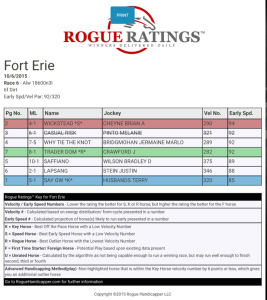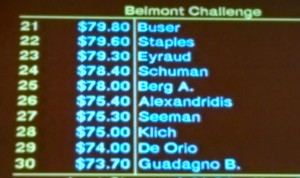Let me start begin with an anecdote. I grew up cheerleading, but I have to admit that I didn’t really understand football beyond the important of scoring touchdowns. However, in college, once the game was finally broken down for me, following the game and rooting for my team became a lot more fun. I was no longer just waiting for someone to score points, instead I was crossing my fingers for a successful 4th and goal. Understanding the concepts is important to any sport you’re trying to get into, and with horse racing, learning the lingo is your first step to playing like the pros.
So that led me here. Just like with football, I came to a point where I wanted to know what was going on in horse racing and figure out how to pick my pony with more legitimacy than basing it on a clever name. I did my research, and lucky for me, I found the Rogue Handicapper® who brings us the genius Rogue Ratings™ system. The more I learned about the complexity behind this sport, the more I realized what an incredible tool Rogue Ratings™ was. As I began to make connections between the terminology and concepts, like what it actually means to handicap a race, how the track conditions play a big part in making predictions, and where past performances come into play, it all started to make sense. As the bigger picture came into focus, the legitimacy and awesomeness of Rogue Ratings™ became even more apparent. I felt like I had to help other newbies break into the horse racing world and go from being observers to players, just like I did.
So as a quick crash course into horse racing terminology, here is my Going Rogue A-Z Guide of Horse Racing Lingo. We will start with the most important definition and question you might be asking… what exactly is Rogue Ratings?
Going Rogue A-Z Guide of Horse Racing Lingo
![]() Rogue Ratings™: a unique handicapping tool that takes the complexity out of thoroughbred handicapping by making calculations for you and delivering educated betting options in a straightforward and easy to read system; making the betting process winnable for the new fans or novice horseplayers in the handicapping game. By the time you get to Z, I believe you’ll have a better idea of how it all works.
Rogue Ratings™: a unique handicapping tool that takes the complexity out of thoroughbred handicapping by making calculations for you and delivering educated betting options in a straightforward and easy to read system; making the betting process winnable for the new fans or novice horseplayers in the handicapping game. By the time you get to Z, I believe you’ll have a better idea of how it all works.
Across The Board: A bet on a horse to win, place or show. Three wagers combined in one. If the horse wins, the player wins all three wagers, if second, two, and if third, one.
Breeders’ Cup: Thoroughbred racing’s year-end championship. Known as Breeders’ Cup Day, it consists of 12 races conducted over two-day’s at a different racetrack each year with purses and awards totaling $26 million. It was first run in 1984.
*In 2014, team Conte-Rogue Handicapper® qualified for The Breeder’s Cup Betting Challenge 2014 [BCQualify.com] by finishing second against a field of 204 players in a one-day qualifying event to win the full $10,000 entry. Then team Conte-Rogue Handicapper® went on to finish third against a field of 286 contestants in the 2014 Breeders’ Cup Betting Challenge 2014.
Conditions: The circumstances under which a race will be run such as: surface, distance, purse, and eligibilities. [Along with this is the Track Condition: the condition of the racing surface. Dirt courses are generally rated Fast, Good, Muddy, or Sloppy. Turf courses are generally rated Firm, Good, Yielding, Soft, or Heavy.
Derby: A stakes race for three year old horses. The Triple Crown is a coveted title where a three-year-old horse wins all three stakes races in a single year. Winning the “Crown of Roses” is considered a Thoroughbred racehorse’s greatest accomplishment. In the United States the three races are The Kentucky Derby, Preakness Stakes and Belmont Stakes. The last winner was in 2015, when American Pharaoh made headlines as he took the title for the first time in 37 years.
Eighth of a mile = a Furlong: 220 yards; 660 feet.
Front Runner: A horse who usually leads (or tries to lead) the field for as far as he can. A horse that wants to run on or near the lead.
Graduate: Winning for the first time (breaking it’s maiden), horse or rider. Also, “graduate claiming” ranks a horse, thus allowing it to participate in the stakes or handicap racing.
Handicap: Race for which a handicapper assigns weights to be carried that are correlated into an odds/points system. Each horse is allocated a different weight to carry, the theory being all horses then run on a fair and equal basis in order to make selections on the basis of past performances.
In-the-Money: To finish in the top three (alternatively, “out of the money” would be a horse that finishes worse than third aka you’re going home a loser, sorry). When you finish in the top three you win, so you get a “Return on Investment” or ROI.!
*With Rogue Ratings, your ROI or “In-the-Money” percentage increases drastically… check out the impressive list of Rogue Handicapper’s Tournament Results [http:// www.roguehandicapper.com/about/tournament-results/].
Juvenile: A two year old horse. The year working towards stakes races for the next year’s derby.
Key Horse: Is highlighted in the color blue with the symbol *K* and is one of the Rogue Ratings™ potential picks for the winner of the race. The Key horse (blue) is generally the “classier horse” because it is not necessarily the fastest horse in the race with early speed, but has a lower velocity rating, meaning it consistently runs well.
*Rogue Ratings™ gives you color coded picks based on handicapping factors that are put into a computer program that creatively deciphers and allows you to make educated bets based on the horse’s calculations of past performances.
Look of Eagles: A horse that has a confident look. John Henry had the Look of Eagles. I had to add this to my glossary because I think the “Look of Eagles” is awesome and needs to become a widely spread term.
Morning Line Odds: The approximate odds quoted by the track prior to the opening of the pools where the participant wagering determines exact odds.
Nose: Smallest advantage a horse can win by.
Odds: The chance of a competitor winning a particular race based on the wagering of the general public in betting pools. Each bet costs $2. If you were to bet on 3-1 odds you would be paid $8, because you win your $2 back times 3, plus your original $2. On a 20-1 you would win $42, a 30-1 bet would pay $62, or a 50-1 bet pay $102.
*More on this later as I begin to figure out exactly what this all means. Statistics was my worst subject in school, so I’m working on learning racing logistics before I worry about the math statistics. Even more of a testament to the simplicity and power of Rogue Ratings because I can easily figure out what it all means.
Past Performances: A compilation of a horse’s record, including all pertinent data such as speed (red horse), pace, form, class (blue horse), and other factors like the race conditions, jockey, and even the post position on the track all used as a basis for handicapping.
*Crunching all of these numbers for each individual horse is nearly impossible for a newbie… which means you need you new best friend at the track, Rogue Ratings™. Rogue Ratings™ gives you handicapping knowledge beyond your experience level. It crunches all of the past performance calculations for you and gives you a color coded, easy to understand look at what those past performance calculations would break down to, in order for you to make an educated bet and compete right along with the pros.
Quinella: Wager in which the first two finishers must be picked in either order. Payoff is made no matter which of the two wins and which runs second.
Rogue Horse: The green highlighted horse with the *R* symbol in the Rogue Ratings™ system, and is one of four possible picks. The green, Rogue horse is the underdog in a way. The Rogue horse (green) just barely misses the chance at being selected the Speed horse (red) or the Key horse (blue) usually due to lower velocities in general, but has may still has a high chance according to the calculations.
Stakes Race: A race for which the owner usually must pay a fee to run a horse. Some stakes races are by invitation and require no payment or fee (The Triple Crown spots are based on a point system to qualify). In return the owners win a “stake” (a trophy or prize money) because in betting, “stake” can also mean the sum of money deposited or guaranteed by the parties to a bet.
Triple Crown: Used generically to denote a series of three important races in a year, but is always capitalized when referring to the historical races for three-year-old thoroughbreds. The Triple Crown races in the United States consist of The Kentucky Derby, Preakness Stakes and Belmont Stakes. Winning the “Crown of Roses” is considered a Thoroughbred racehorse’s greatest accomplishment. The last winner was crowned in 2015, when American Pharaoh made headlines as he took the title for the first time in 37 years.
Untried: Not raced or tested for speed.
Velocity: How fast a horse carries its speed and efficiently distributes its energy from starting gate to to finish line.
*With Rogue Ratings, the lower the velocity number the better, as a horse that runs a zero would be perfectly (equally) distributing his energy. Horses can even have a negative velocity number, which would make for even higher efficiency.
Withdrawn [or Scratched]: A horse that is scratched and therefore withdrawn from a race before the start. Horses can be withdrawn due to adverse track conditions or because of illness or injury.
*Rogue Ratings will recalculate if any horse is withdrawn and can adjust their picks in real time. This lets you see how the recalculated race now looks with the changes and which horses to potentially bet in a race.
EXacta: A bet in which the player attempts to pick the 1st and 2nd place horse on one ticket and is sometimes referred to as a “Perfecta,” (a “Trifecta” would be the first three finishers).
*With these types of bets, you can “box” your horses, which means you win your bet as long as any of the horses that you have included in your exacta box wager finishes first or second, regardless of the order, you win!
Yellow Horse: The fourth type of pick in the Rogue Ratings™ computer program is called the First-Time Starter horse. The yellow *FTS* pick is based on a race simulation projection, which means the horse meets a base velocity requirement required by the Rogue Ratings™ computer program and determines from it’s calculation that this horse is strong enough to win a race for it’s first start ever on the racetrack.
Zodiac & Zippity Doo Dah: examples of names that would sway me to bet my $2 without any logical reason whatsoever.
Thank you to SBNation [http://www.sbnation.com/2015/5/2/8535065/horse-racingglossary-exacta-trifecta], [http://www.ildado.com/horse_racing_glossary03.html], and Daily Racing Form [http://www1.drf.com/help/help_glossary.html] for helping me with my go to guide.
 Going Rogue by Kayla Staples - Kayla Joy Staples is excited to be part of the Rogue Handicapping team. Originally from Tucson, Arizona this desert girl grew up exploring the outdoors, going to horse camps and was always up for a new adventure or challenge. Leaving Tucson for UCLA, Kayla became an active member of the Kappa Kappa Gamma sorority and graduated with a degree in Sociology and Anthropology. After attending a sorority alumni event at the horse track a few years ago, Kayla became increasingly interested in horseracing, and connected with the Rogue Handicapping team to help bring horseracing to the new generation of novice players, who like her want to get in the game (with a little help from the pros).
Going Rogue by Kayla Staples - Kayla Joy Staples is excited to be part of the Rogue Handicapping team. Originally from Tucson, Arizona this desert girl grew up exploring the outdoors, going to horse camps and was always up for a new adventure or challenge. Leaving Tucson for UCLA, Kayla became an active member of the Kappa Kappa Gamma sorority and graduated with a degree in Sociology and Anthropology. After attending a sorority alumni event at the horse track a few years ago, Kayla became increasingly interested in horseracing, and connected with the Rogue Handicapping team to help bring horseracing to the new generation of novice players, who like her want to get in the game (with a little help from the pros).

 So after the big American Pharaoh Triple Crown win, my interest was peaked. I liked horse racing but quickly learned this was not as easy to break into as I had thought. I did my research to see how I could compete without reverted back to the insecurity of my sophomore year Statistcs 101 final, where I was barely hoping to come out with a passing grade, let alone a big win A+. I decided to look into the Rogue Rating buzz and I wanted to put this new app to the test. From what I understood Rogue Ratings was an algorithm that plugs and chugs and calculates everything, taking the calculations off your mind so you can just focus on your best bet. Rogue Ratings did the stats stuff for me—I was a fan.
So after the big American Pharaoh Triple Crown win, my interest was peaked. I liked horse racing but quickly learned this was not as easy to break into as I had thought. I did my research to see how I could compete without reverted back to the insecurity of my sophomore year Statistcs 101 final, where I was barely hoping to come out with a passing grade, let alone a big win A+. I decided to look into the Rogue Rating buzz and I wanted to put this new app to the test. From what I understood Rogue Ratings was an algorithm that plugs and chugs and calculates everything, taking the calculations off your mind so you can just focus on your best bet. Rogue Ratings did the stats stuff for me—I was a fan.





Follow RogueHandicapper